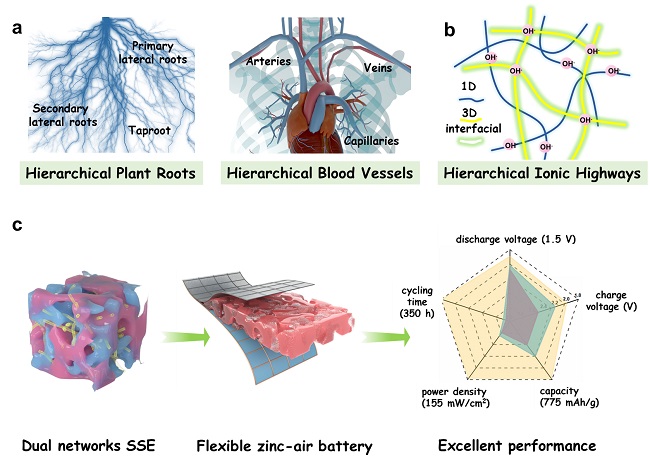Flexible zinc-air batteries have the advantages of high theoretical energy density, good safety, and low cost, and they have broad application prospects in wearable devices and other fields.
The widely used solid-state electrolytes (SSEs) for flexible zinc-air batteries are the gel polymer electrolytes (GPEs) composed of KOH solution and inert polymer matrixes. High corrosion of KOH solution and the potential structure instability for GPEs under highly corrosive electrochemical environments cause severe safety risks and battery failure.
Anion-exchange membranes (AEMs), another type of SSEs, avoid using highly corrosive solutions. However, the low ion conductivity and poor water uptake of AEMs lead to the fast degradation of battery performance within several hours. Therefore, the main challenge for the applications of flexible zinc-air batteries is the absence of reliable SSEs.
Recently, a research group led by Prof. CHEN Zhongwei from the Dalian Institute of Chemical Physics (DICP) of the Chinese Academy of Sciences (CAS), inspired by plant roots and blood circulation systems, has constructed a safe, environment-friendly, single-anion conductive SSEs with hierarchical ionic highways. They assembled these SSEs on a zinc-air battery, which showed good electrochemical performance and long cycle life. The study was published in Angewandte Chemie-International Edition.

Design and fabrication of single-anion conductive SSEs with hierarchical ionic highways for high-performance Zn-air battery(Image by XU Mi)
The researchers constructed SSEs by in-situ polymerization of a single OH--conductive ionomer within the hybrid matrix of functional carbon nanotubes and polyacrylamide hydrophilic polymer. They have obtained the fabricated SSEs dual-penetrating ionomer-polymer networks and hierarchical ionic highways, which contributed to mechanical robustness with 1200% stretchability, decent water uptake and retention, and superhigh ion conductivity of 245 mS/cm and good Zn anode reversibility.
Moreover, they assembled these SSEs on flexible solid-state zinc-air batteries, delivering a high specific capacity of 764 mAh/g, peak power density of 152 mW/cm2, and sustained good cycling stability for 1050 cycles (350 hours).
"This work offers a new paradigm of OH- conductors and broadens the definition and scope of OH- conductors," said Prof. CHEN.
This work was supported by the Strategic Priority Research Program of CAS, the Energy Revolution S&T Program of Yulin Innovation Institute of Clean Energy, and the Postdoctoral Fellowship Program of CPSF. (Text by XU Mi)